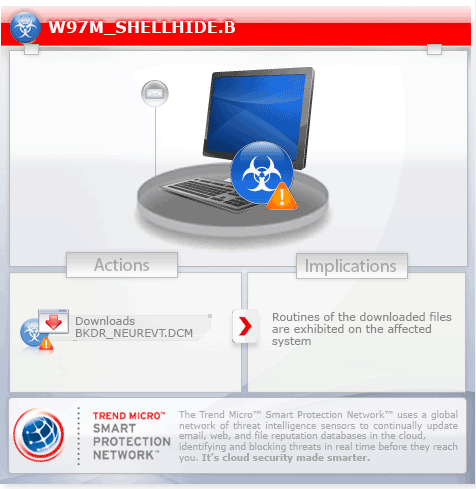W97M_SHELLHIDE.B
Trojan.Mdropper (Symantec), Troj/DocDrop-BX (Sophos)
Windows 2000, Windows Server 2003, Windows XP (32-bit, 64-bit), Windows Vista (32-bit, 64-bit), Windows 7 (32-bit, 64-bit)


Threat Type: Trojan
Destructiveness: No
Encrypted: No
In the wild: Yes
OVERVIEW
This malware leverages a macro-enabled word document as a malicious spam attachment in order to infect machines with a backdoor. The spammed email message is related to payment remittance.
To get a one-glance comprehensive view of the behavior of this Trojan, refer to the Threat Diagram shown below.

This Trojan arrives as an attachment to email messages spammed by other malware/grayware or malicious users.
It executes the downloaded files. As a result, malicious routines of the downloaded files are exhibited on the affected system.
TECHNICAL DETAILS
Arrival Details
This Trojan arrives as an attachment to email messages spammed by other malware/grayware or malicious users.
Download Routine
This Trojan connects to the following website(s) to download and execute a malicious file:
- http://{BLOCKED}cu.com/{BLOCKED}ek/sb01ff.exe
It saves the files it downloads using the following names:
- %Application Data%\APWARQFJESX.exe - detected as BKDR_NEUREVT.DCM
(Note: %Application Data% is the current user's Application Data folder, which is usually C:\Documents and Settings\{user name}\Application Data on Windows 2000, XP, and Server 2003, or C:\Users\{user name}\AppData\Roaming on Windows Vista and 7.)
It then executes the downloaded files. As a result, malicious routines of the downloaded files are exhibited on the affected system.
NOTES:
This document has a malicious macro script that downloads and executes a malicious file when the document is opened.
SOLUTION
Step 1
Before doing any scans, Windows XP, Windows Vista, and Windows 7 users must disable System Restore to allow full scanning of their computers.
Step 3
Scan your computer with your Trend Micro product to delete files detected as W97M_SHELLHIDE.B. If the detected files have already been cleaned, deleted, or quarantined by your Trend Micro product, no further step is required. You may opt to simply delete the quarantined files. Please check this Knowledge Base page for more information.
Did this description help? Tell us how we did.

